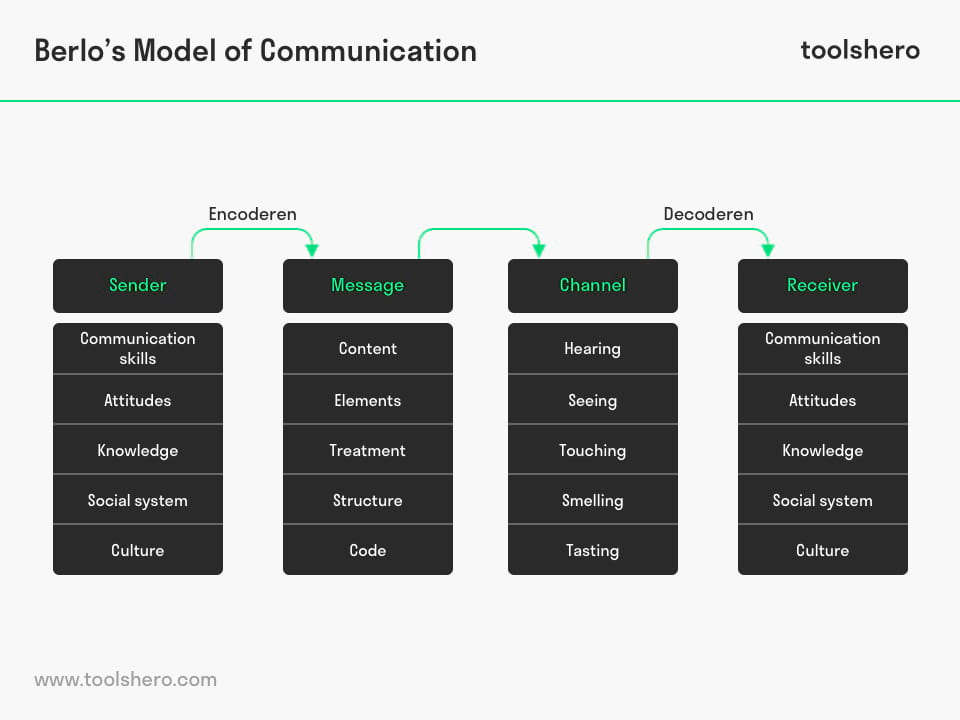David Berlo’s SMCR Model of Communication explained

Berlo’s SMCR model of communication: this article provides a practical explanation of Berlo’s SMCR model of communication. Next to what it is, this article also highlights the components with examples and a summary. After reading, you’ll understand the basics of this communication theory. Enjoy reading!
What is Berlo’s SMCR Model of Communication?
David Berlo’s SMCR Model of Communication represents the process of communication in its simplest form. The acronym SMCR stands for Sender, Message, Channel, and Receiver.
Berlo’s SMCR Model of Communication (1960) describes the different components that form the basic process of communication. Because this communication tool also emphasises the coding and decoding of the message, it can be used for more efficient communication.
As far back as ancient Greece, Aristotle already wrote about communication processes. He described three primary aspects of all forms of communication: the speaker, the subject, and the person who receives the message.
He argued that it is the listener who ultimately determines the meaning of any particular message. Similar to modern theories on communication, Berlo’s SMCR Model of Communication describes four components of communication.
Origin and history of the Berlo’s SMCR Model of Communication
In 1948, the Bell System Technical Journal published a Communication Cycle model, developed by Claude Shannon and Warren Weaver. This model was initially developed to improve technical communication, but would later be applied in many other fields.
In 1960, David Berlo expanded on this linear communication model and created the SMCR Model of Communication.
Today, the sender-receiver framework is often used in communication sciences. Lasswell’s communication model, for example, consists of a similar framework.

Figure 1 – SMCR Model of Communication (Berlo, 1960)
Components of Berlo’s SMCR Model of Communication
Berlo’s SMCR Model of Communication includes four components that describe the communication process. The different components in the model are influenced by various factors.
Sender
The sender of the message is the source who creates and sends the message to the receiver. The source is the start of the communication process and is the person who encodes the message.
Factors that may influence the sender are also applicable to the receiver. Consider how the message is interpreted, for example. Berlo’s SMCR Model of Communication identifies the following factors that affect the source:
Communication skills
Communication skills include: reading, listening, speaking etc.
Attitude
One’s attitude in relationship to the audience, receiver and subject changes the meaning and consequence of the message.
Knowledge
Familiarity with the subject of the message makes communication more effective.
Social systems
Values, beliefs, religion and rules influence the way in which the sender communicates the message, alongside location and circumstances.
Culture
Cultural differences may result in the message being interpreted differently.
Message
The message is the package of information or meaning that is sent from sender to receiver. The message can be sent in various forms, such as audio, speech, text, video or other media.
The sender of the messages always wants the receiver to interpret the message in a certain way. The source’s intention is therefore translated into a coded message. The receiver should understand the message with reasonable accuracy. The message is influenced by:
Content
The content of the message from beginning to end.
Elements
Elements are (non)verbal aspects, such as gestures and signs, that may influence the message. Albert Mehrabian’s 7 38 55 rule of Communication goes into this in more detail.
Treatment
Treatment refers to the way in which the message is sent, the message’s packaging.
Structure
As the word suggests, the structure of the message refers to the way in which it is structured.
Code
The code of the message is the form in which the message is sent. This may include text, language, video, gestures, music, etc.
Channel
The channel is the medium used to send the message. The medium must be able to be picked up by the sensory system of the receiver and may therefore involve vision, sound, smell, taste or touch. Humans have the following senses:
- Hearing
- Seeing
- Touching
- Smelling
- Tasting
Mass communication always involves technical tools, such as phones, the Internet and television. In these cases, the transmitted information is assimilated via vision and sound.
Receiver
The receiver is the person who receives and subsequently decodes the coded message. In a linear communication process, the receiver is always located at the end.
In order to make communication as effective and smooth as possible, Berlo’s SMCR Model of Communication assumes the receiver’s thinking pattern must be in accordance with that of the sender.
The same factors therefore influence this component in Berlo’s SMCR Model of Communication. After all, the receiver decodes the message him/herself and gives it their own meaning.
A Disrupted Communication Process
In practice, communication is not nearly as smooth as described in Berlo’s linear model. There are a number of factors that may lead to a disrupted communication process. Examples of disruptions include:
Loss or distortion
The person sending the message must encode the message in such a way that the full intention of the message is clear. He/she may choose to do this with words, but it is very rare that the full intention is encoded in a message. In some cases, a message may even barely contain the information the sender wants to convey.
Even if an additional channel is added to the communication process, the message may become distorted. For example, consider the familiar team-building game where a message is constantly passed on in a circle of people.
The last person will often hear a completely distorted or unrecognisable message. Every time the message is conveyed by a different person, part of its initial intention is lost.
Noise
After the message is sent, noise may occur. This noise disrupts the source and message and causes the receiver to only partially receive the message or not at all. Internal noise refers to a state in which part of the communication process, the receiver for example, is not feeling well, or not entirely focussed.
As a result, the receiver may miss out on certain parts of the message. External noise, on the other hand, may be caused by background noise during a phone call, for example. This also causes the receiver to potentially misunderstand certain parts of the message.
There may also be situations in which noise is caused intentionally. Non-intentional noise is caused unintentionally and can, for example occur if sender uses difficult words, which then makes it more difficult for the receiver to understand the message.
Berlo’s SMCR Model Synchronisation
The communication process may be either synchronous or asynchronous. If the receiver is in direct contact with the sender, this is referred to as a synchronous channel or process.
If, on the other hand, the sender and receiver are not in direct contact with each other, this is referred to as an asynchronous communication process.
The danger of asynchronous communication is that both the sender and receiver will not receive direct feedback on how the message is conveyed. It also prevents the message from being adjusted, making it impossible to clarify certain matters further.
To summarise Berlo’s SMCR Model
Berlo’s SMCR Model of Communication presents the communication process in its simplest form. The model consists of four component that are each influenced by different factors. To ensure the message is conveyed as effectively as possible, the sender and the receiver must share some common ground.
Communication skills play a crucial role in this. Other factors, such as culture, knowledge and attitude are also vital. What may be considered rude in some cultures, may be perfectly fine in others. Communication doesn’t always go as smoothly as one would hope. Various problems, such as disruptions, noise and an asynchronous process, may obstruct proper communication.
Now it’s your turn
What do you think? Are you familiar with Berlo’s SMCR Model of Communication? What do you believe are factors that contribute to smooth communication? Alternatively, what factors may disrupt or complicate communication? Do you have any tips or additional comments?
Share your experience and knowledge in the comments box below.
More information
- Baird, L. L. (1983). The search for communication skills. ETS Research Report Series, 1983(1), i-48.
- Underwood, M. (2003). Berlo’s smcr model. Retrieved March, 19, 2007.
- Turaga, R. (2016). Organizational models of effective communication. The IUP Journal of Soft Skills, 10(2), 56-65.
How to cite this article:
Janse, B. (2018). Berlo’s SMCR Model of Communication. Retrieved [insert date] from Toolshero: https://www.toolshero.com/communication-methods/berlos-smcr-model-of-communication/
Original publication date: 01/08/2019 | Last update: 04/10/2024
Add a link to this page on your website:
<a href=”https://www.toolshero.com/communication-methods/berlos-smcr-model-of-communication/”>Berlo’s SMCR Model of Communication</a>









